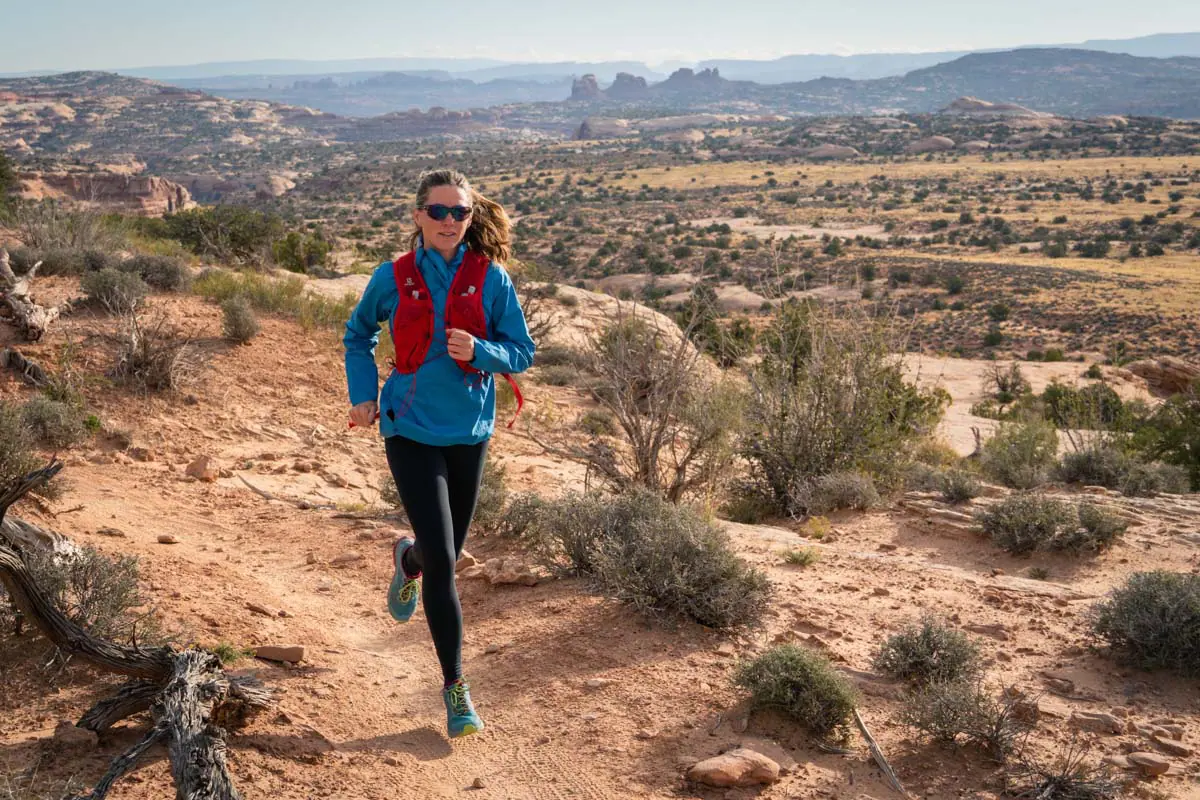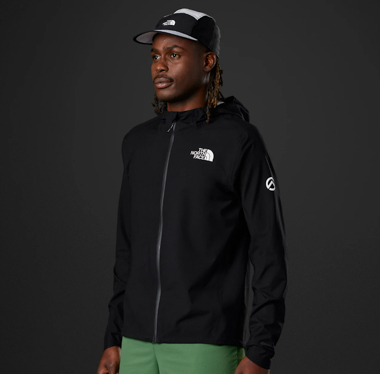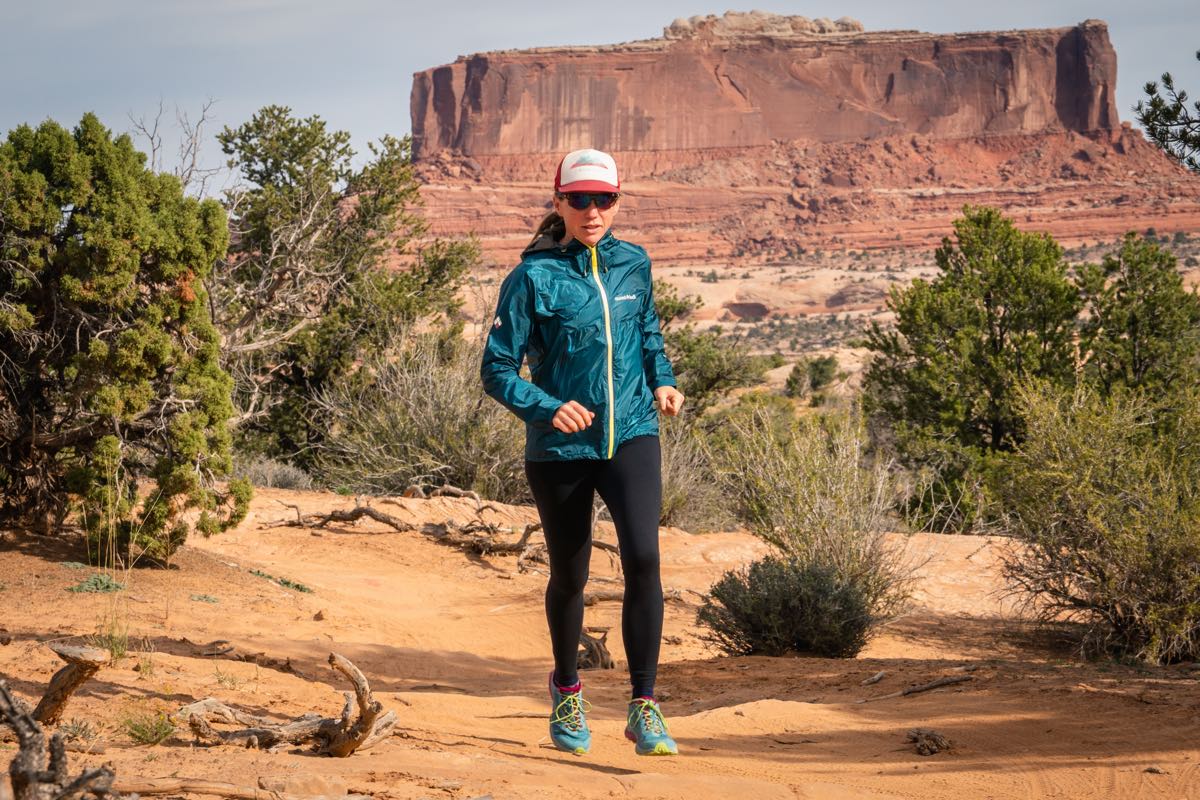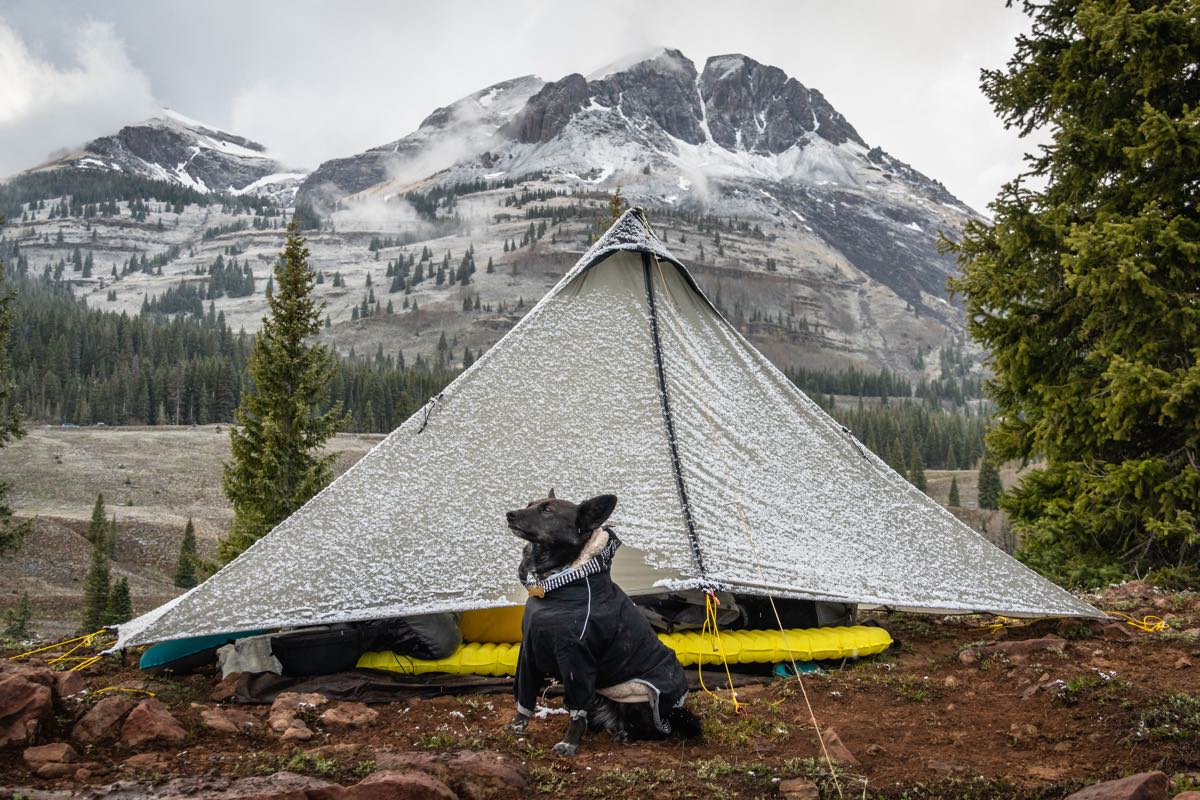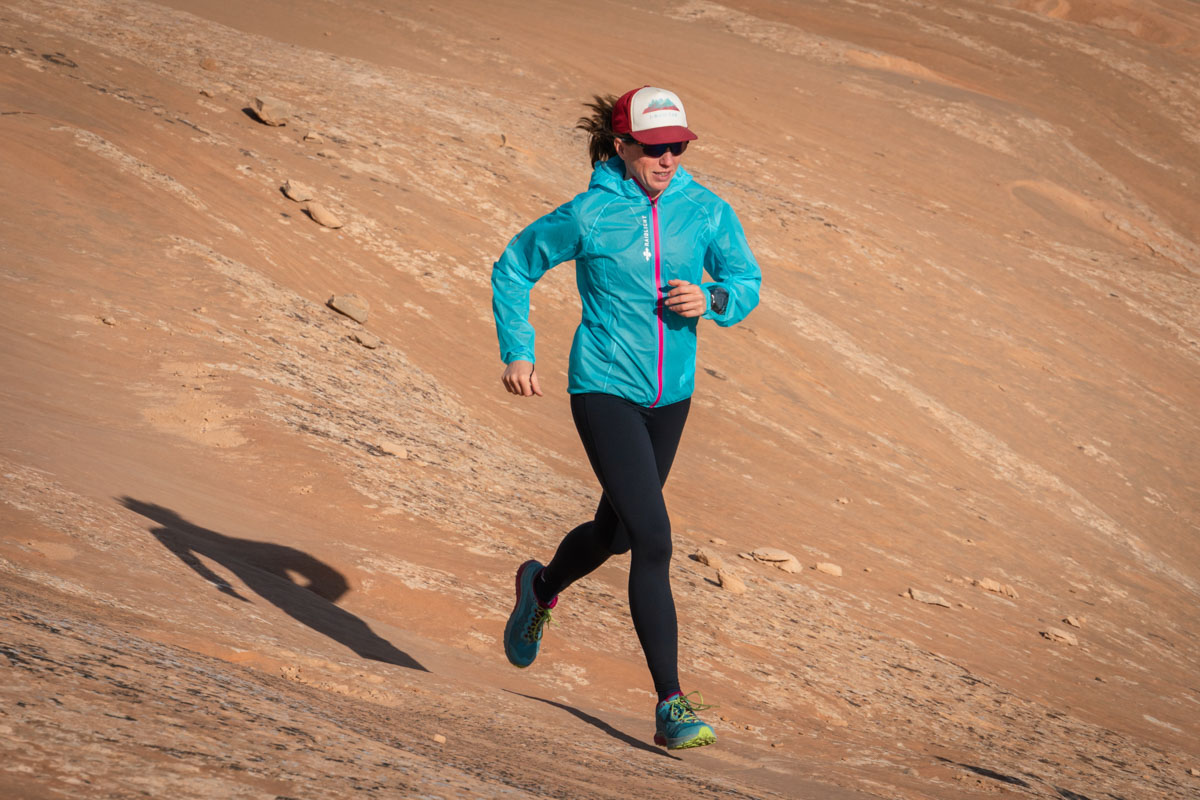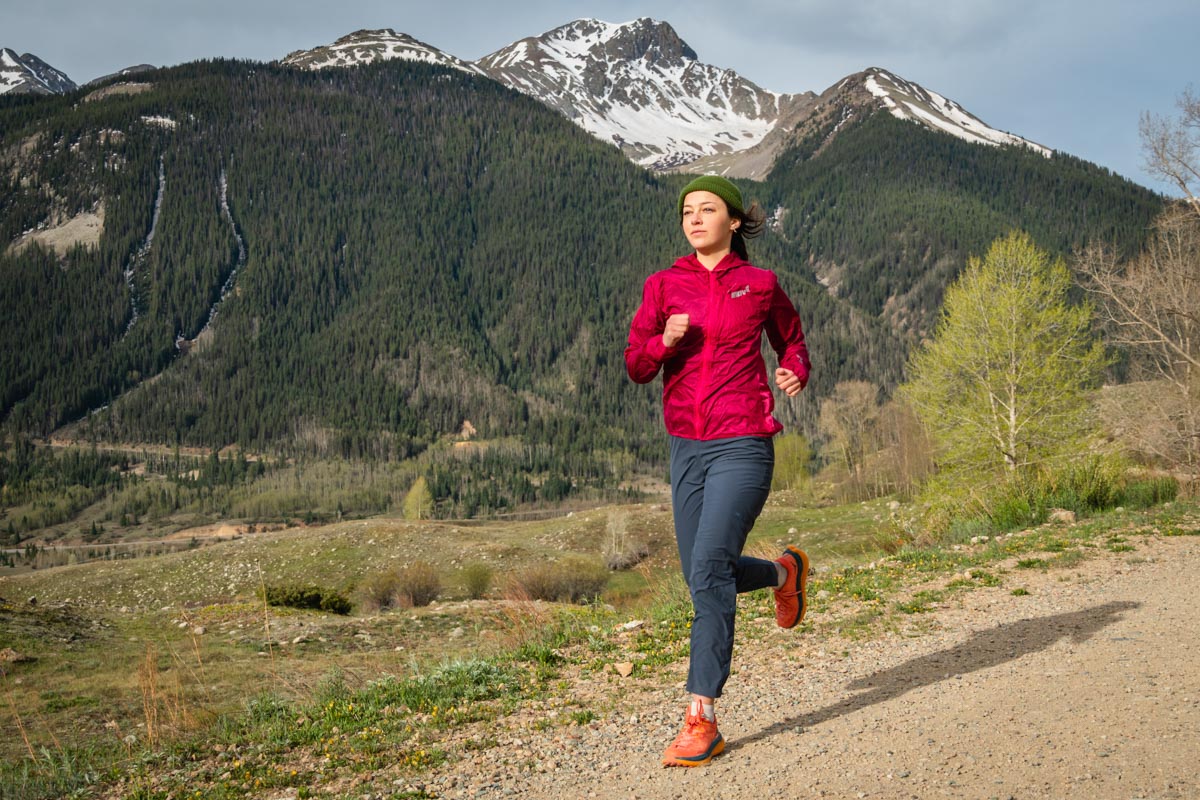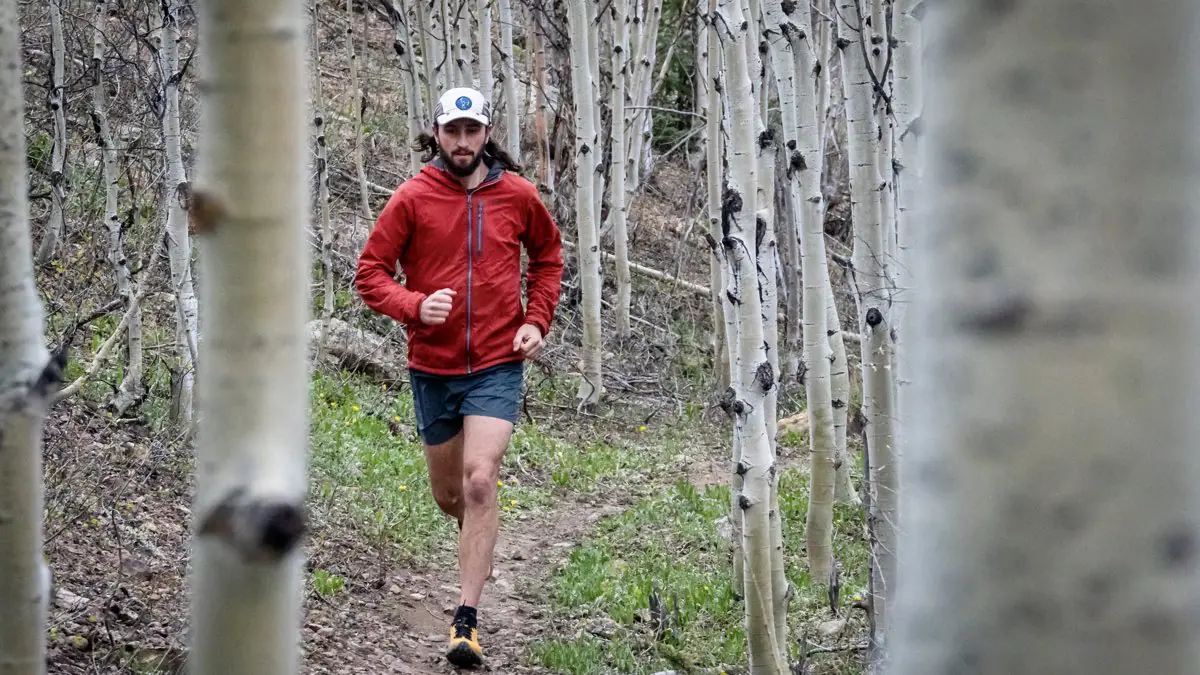
Ben Kilbourne runs away from the rain while testing rain jackets in Colorado. Photo: iRunFar/Eszter Horanyi
When you want to be able to get out and run in the rain, finding the best running rain jacket for your conditions can make your run much more pleasant. As far as athletes go, we runners aren’t usually known for our fair-weather tendencies. We still get out there when the raindrops start to fall — and when the going gets tough, we keep on going.
While splashing through some puddles or weathering a drizzle on a short run may not be a big deal, extended wet weather on a long run can range from simply uncomfortable to downright dangerous in cooler temperatures. The team at iRunFar tested a collection of running rain jackets in some seriously wet conditions to determine the best options for rainy adventures. We wanted to determine the best rain jacket for running and categorized them into great overall jackets and excellent ultralight ones.
After chasing all the precipitation we could in as many conditions as possible, we narrowed the list to what we found to be the best rain jackets for running.
For more background information, see our buying advice, testing methodology, and frequently asked questions below.
If you’re looking for a windbreaker jacket instead, be sure to check out our best running windbreaker jackets guide.
Best Running Rain Jackets
- Best Overall Running Rain Jacket: The North Face Summit Series Superior Futurelight Jacket
- Best Running Rain Jacket – Runner-Up: Montbell Rain Trekker Jacket
- Best of the Rest Running Rain Jackets: Outdoor Research Helium Rain Jacket and Montbell Versalite Jacket
- Best Ultralight Running Rain Jacket: inov-8 Raceshell HZ Unisex
- Best Ultralight Running Rain Jacket – Runner-Up: Rab Phantom Waterproof Pull-On Jacket
Best Overall Running Rain Jacket: The North Face Summit Series Superior Futurelight Jacket ($290)
The North Face Summit Series Superior Futurelight Jacket is the top running rain jacket, and one our testers hail for its performance on long bad-weather days, and it is also a top choice for snowy winter runs. This three-layer jacket’s combination of The North Face’s Futurelight 3L material, fully taped seams, and an external durable water repellent (DWR)-treated nylon layer kept rain and snow out and was one of our top performers in breathability as well.
An adjustable hood and hem help to dial in fit and keep the weather out. The wrist cuffs, which are cut to go over the back of the hand a bit, add even more protection. We also found this material to be nice and quiet when in motion.
Our testers found the internal mesh pocket on the jacket useful for storing small items and easily accessible on the run. Interestingly, the internal pocket is on the right side of the chest in the men’s version and at the low left hem on the women’s version.
The bottom cinch cord makes it easy to dial in the fit and level of protection of this jacket.
One tradeoff for this jacket’s all-day level of protection is its weight. It is one of the heaviest we tested, though it is lighter than the previous version of this jacket, The North Face Lightriser Futurelight Waterproof Jacket.
Here’s our The North Face Lightriser Futurelight Waterproof Jacket review, the predecessor to this The North Face Summit Series Superior Futurelight Jacket and an almost identical jacket.
Actual Weight (men’s medium): 226 grams (8.3 oz.)
Material: The North Face Futurelight 3L waterproof membrane
Construction: 3 layers
Pros:
- Excellent breathability
- Good protection from rain and snow
- Quiet material for less noise on the trails
Cons:
- Heavier than others tested
- Very expensive
Shop The North Face Men's Summit Series Superior Futurelight JacketShop The North Face Women's Summit Series Superior Futurelight Jacket
Best Running Rain Jacket – Runner-Up: Montbell Rain Trekker Jacket ($200)
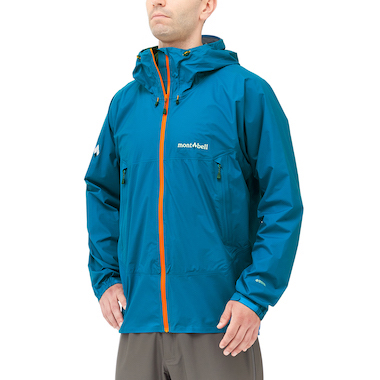 The Montbell Rain Trekker Jacket is a feature-filled jacket that earned high marks from our testers for its combination of waterproofness and breathability. Montbell built this jacket using a single piece of fabric. This unique K-Mono Cut design reduces both weight and the number of seams for better protection from the elements. Any seams are fully sealed to prevent moisture entry.
The Montbell Rain Trekker Jacket is a feature-filled jacket that earned high marks from our testers for its combination of waterproofness and breathability. Montbell built this jacket using a single piece of fabric. This unique K-Mono Cut design reduces both weight and the number of seams for better protection from the elements. Any seams are fully sealed to prevent moisture entry.
The Gore-Tex Infinium Windstopper waterproof membrane is paired with a 20-denier nylon outer with a durable water repellent (DWR) coating to create a lightweight yet protective two-layer jacket that our testers found functions well on both rainy days and in winter snowstorms. Multiple adjustment points on the hood, cuffs, and hem allow for a customizable fit to optimize comfort and better protect from wet weather.
Additional features include a water-resistant zipper, hook-and-loop closures to secure the hood when not in use, and a sewing pattern that allows for arm range of motion without pulling on the body of the jacket. Runners who get annoyed with the swishing sound that many rain jackets make when in motion will appreciate the quiet fabric of this jacket.
We found the sizing adequate for layering and wearing a small pack underneath, but for bulkier layers or a larger loaded pack, you will likely need to size up. Two waterproof external pockets on the chest can accommodate small items for easy access. The pack also comes with a separate stuff sack for storing it on the go.
Actual Weight (men’s medium): 201 grams (7 oz.)
Material: Gore-Tex Infinium Windstopper
Construction: 2 layers
Pros:
- Quiet fabric is less distracting on the trails
- Good combination of waterproof yet breathable
- Fewer seams for potential moisture entry
Cons:
- Separate stuff sack could be easy to misplace
- Not as breathable as some other jackets tested
Shop the Men's Montbell Rain Trekker JacketShop the Women's Montbell Rain Trekker Jacket
Best of the Rest Running Rain Jacket: Outdoor Research Helium Rain Jacket ($159)
 The Outdoor Research Helium Rain Jacket is a lightweight waterproof jacket that packs a lot of punch for its price point. While it certainly isn’t inexpensive, the number of features and the amount of protection it offers make it well worth the investment. This is a 2.5-layer jacket featuring a Pertex Shield waterproof membrane coupled with a 30-denier nylon outer to provide excellent durability and water protection in a very lightweight package. It has fully taped seams, a water-resistant zipper, and an adjustable hem and hood. In fact, this jacket’s hood was our favorite, with plenty of volume to accommodate a winter hat, brimmed hat, or large ponytail. An adjustable bungee kept it in place when the rain and wind hit.
The Outdoor Research Helium Rain Jacket is a lightweight waterproof jacket that packs a lot of punch for its price point. While it certainly isn’t inexpensive, the number of features and the amount of protection it offers make it well worth the investment. This is a 2.5-layer jacket featuring a Pertex Shield waterproof membrane coupled with a 30-denier nylon outer to provide excellent durability and water protection in a very lightweight package. It has fully taped seams, a water-resistant zipper, and an adjustable hem and hood. In fact, this jacket’s hood was our favorite, with plenty of volume to accommodate a winter hat, brimmed hat, or large ponytail. An adjustable bungee kept it in place when the rain and wind hit.
The single zip pocket on this jacket also serves as a stuff sack for storing the jacket when not in use. The somewhat relaxed fit allows for some layering, but it’s not so loose that it flaps around while on the move. We recommend sizing up to accommodate thicker layers or a hydration pack underneath. The jacket is less breathable than some others we tested and felt a little muggy on warmer runs.
Actual Weight (men’s medium): 178 grams (6.3 oz.)
Material: Pertex Shield
Construction: 2.5 layers
Pros:
- Lightweight, durable, and easily packable
- Nice features for the price make it a good value
- Hood is the best we tested
Cons:
- Can feel muggy in warmer temperatures due to less breathability
- Not super form-fitting but still need to size up for layering
Shop the Men's Outdoor Research Helium Rain JacketShop the Women's Outdoor Research Helium Rain Jacket
Best of the Rest Running Rain Jacket: Montbell Versalite Jacket ($219)
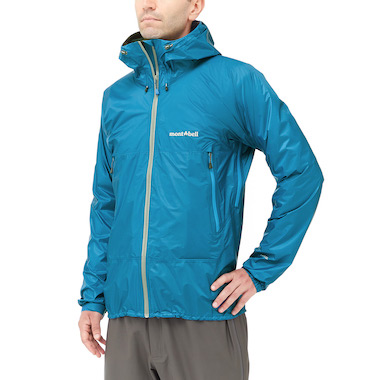 The Montbell Versalite Jacket is another great jacket offering from the Japanese company. The Montbell Versalite Jacket shares many features with the overall winner we reviewed above, the Montbell Rain Trekker Jacket. These include the fully sealed seams, adjustable hood, hem, and cuffs, articulated arm design, water-resistant zippers, pocket configuration, stuff sack, and the seam-reducing K-Mono Cut design.
The Montbell Versalite Jacket is another great jacket offering from the Japanese company. The Montbell Versalite Jacket shares many features with the overall winner we reviewed above, the Montbell Rain Trekker Jacket. These include the fully sealed seams, adjustable hood, hem, and cuffs, articulated arm design, water-resistant zippers, pocket configuration, stuff sack, and the seam-reducing K-Mono Cut design.
While there are many similarities between the two jackets, there are several features that make the Montbell Versalite Jacket stand out. The jacket uses the same Gore-Tex Infinium Windstopper waterproof membrane but with a lighter 10-denier durable water repellent (DWR)-coated nylon outer. This reduces the weight compared to the Montbell Rain Trekker Jacket, but we did notice that the outer material was a little louder and crinklier. The 10-denier nylon does raise a question about long-term durability, but our testers have not yet encountered any issues after months of testing.
One of the standout differences of this jacket from all the others we tested is the pit zips for venting and breathability, a feature that is virtually nonexistent in the running jacket world. The ability to unzip the armpit area of the jacket significantly improves its breathability and heat management, making it a great option for runners who need full waterproof coverage in warmer climates or who just run a bit hot.
Actual Weight (men’s medium): 188 grams (6.6 oz.)
Material: Gore-Tex Infinium Windstopper
Construction: 2 layers
Pros:
- Pit zips provide ventilation and heat management
- Lightweight with excellent waterproofness
- Reduced number of seams
Cons:
- Lighter weight nylon outer may prove less durable
- Outer material is louder than others tested
Shop the Men's Montbell Versalite JacketShop the Women's Montbell Versalite Jacket
Best Ultralight Running Rain Jacket: inov-8 Raceshell HZ Unisex ($155)
 For gram-counting runners who want a trusted jacket that weighs as little as possible, the inov-8 Raceshell HZ Unisex ticks all the boxes. It is an anorak-style jacket that provides full waterproof protection at nearly half the weight of most other jackets in this guide. This 2.5-layer, half-zip jacket features fully taped seams inside a polyester outer with a polyurethane waterproof membrane. This extremely light and packable jacket meets the mandatory kit requirements for most races — but always double-check your race’s requirements and jacket specs to be sure!
For gram-counting runners who want a trusted jacket that weighs as little as possible, the inov-8 Raceshell HZ Unisex ticks all the boxes. It is an anorak-style jacket that provides full waterproof protection at nearly half the weight of most other jackets in this guide. This 2.5-layer, half-zip jacket features fully taped seams inside a polyester outer with a polyurethane waterproof membrane. This extremely light and packable jacket meets the mandatory kit requirements for most races — but always double-check your race’s requirements and jacket specs to be sure!
We appreciate that the lightweight material is quiet when running and is also translucent. This means your race number will be visible underneath the jacket. It will also mean you are wearing the fashion equivalent of a highly technical plastic bag — functional but not exactly stylish.
The ultralight construction comes at a cost. Reducing weight means that there are some compromises in the jacket’s features. The jacket’s hood, cuffs, and hem are not adjustable, so there is very little flexibility for an individual fit. The jacket has a wider profile that provides some room for a pack underneath and makes the pullover style of the jacket easy enough to get on and off. Additionally, the zipper on this jacket can be a bit stiff and slow, so we had to be a bit more careful to avoid pulling on it too aggressively to prevent breakage and material tears.
You can also read our in-depth inov-8 Raceshell HZ Unisex review.
Actual Weight (men’s medium): 94 grams (3.3 oz.)
Material: Polyurethane membrane
Construction: 2.5 layers
Pros:
- Very lightweight and packable
- Can fit a pack underneath
Cons:
- Lower weight means less adjustability and features
- Zipper is stiff and slow
Best Ultralight Running Rain Jacket – Runner-Up: Rab Phantom Waterproof Pull-On Jacket ($200)
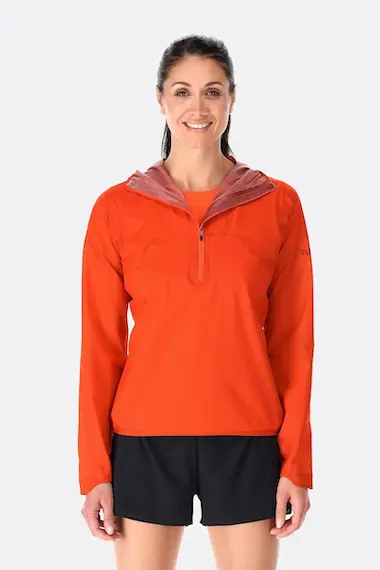 The Rab Phantom Waterproof Pull-On Jacket is an anorak-style waterproof jacket that topped our list for its impressively light weight and breathability. While this jacket shares some design similarities with the inov-8 Raceshell HZ Unisex, the cut of the Rab Phantom Waterproof Pull-On Jacket is much slimmer, and we recommend sizing up if you plan to wear this over heavier layers or a pack.
The Rab Phantom Waterproof Pull-On Jacket is an anorak-style waterproof jacket that topped our list for its impressively light weight and breathability. While this jacket shares some design similarities with the inov-8 Raceshell HZ Unisex, the cut of the Rab Phantom Waterproof Pull-On Jacket is much slimmer, and we recommend sizing up if you plan to wear this over heavier layers or a pack.
The jacket features a 2.5-layer construction with a Pertex Shield waterproof membrane, and the seams are fully taped for maximum protection. To save weight, this ultralight jacket skips bungees on the hood, cuffs, and hem and lacks adjustability. It also doesn’t have any pockets. The water-resistant zipper was smooth and moved well with no catching. The material has some stretch, which makes it comfortable on the move. Its slimmer profile and tighter fit, while useful for keeping the jacket from shifting or flapping, make it more difficult to take on and off quickly while running. Additionally, we found the material of this jacket to be much louder than some of its counterparts, which can be distracting out on the trail.
Read our in-depth Rab Phantom Waterproof Pull-On Jacket review.
Actual Weight (men’s medium): 96 grams (3.4 oz.)
Material: Pertex Shield
Construction: 2.5 layers
Pros:
- Very lightweight and packable
- Material has some stretch for comfort and ease of movement
- Stuff sack included for packing
Cons:
- Slim fit is more difficult to get on and off and does not accommodate many layers or a pack underneath
- Material is noisy when moving
Shop the Men's Rab Phantom Waterproof Pull-On JacketShop the Women's Rab Phantom Waterproof Pull-On Jacket
Running Rain Jackets Glossary
The technology that goes into technical waterproof outdoor gear such as running rain jackets is impressive — and can get confusing! We share some definitions for common waterproof gear terms to help clarify their meanings.
Durable Water Repellent (DWR) Coating: A coating applied to fabric that causes water to bead up on the surface and roll off, preventing water from soaking into the material. DWR coatings are historically fluoropolymer based, though many companies are working toward using non-perfluorinated chemicals (non-PFC) due to environmental concerns.
Moisture Vapor Transmission Rate (MVTR): A laboratory testing method to measure a material’s breathability by the amount of moisture vapor (our sweat) that can pass through the fabric. It is measured in grams of vapor per square meter of fabric per 24 hours. The higher the number, the more breathable the material. A moderate breathability rating starts at around 10,000 g/m2.
Resistance to Evaporative Heat Loss (RET): Another measure of the breathability of material that measures the resistance of the material to water vapor. The lower the resistance, the more vapor can pass through. The lower the RET, the more breathable the material, with a rating less than 13 considered good breathability during activity.
Hydrostatic Head Test: A laboratory test to quantify the waterproofness of a material. Material is stretched over the end of a one-inch diameter tube, and a column of water (measured in millimeters) is added to the tube and observed for 24 hours. The rating measures how many millimeters of water a fabric can hold (millimeters of water pressure) before it soaks through. The water height at which the water seeps through the fabric is called the hydrostatic head. The higher the number, the more waterproof the material, with the lower end of waterproof jackets starting at around 10,000 millimeters.
Schmerber Unit: Another name for the hydrostatic head waterproofness measure named for Charles Edouard Schmerber, who created the hydrostatic head test.
Waterproof Membrane: A synthetic material membrane that blocks and repels water. It is usually bonded or layered with an outer material layer and/or inner liner to create a waterproof jacket. Common brands include Gore-Tex, eVent, Polartec Neoshell, and Pertex.
Denier: Measurement of the thickness of a material’s fiber. A higher denier denotes a thicker and, therefore, often more durable fiber.
Wetting Out: The point at which the amount or pressure of water overwhelms the waterproof capability of a jacket material.
Shakedry: A type of waterproof jacket constructed with the waterproof membrane as the external material instead of layered inside other materials, such as nylon.
Buyer’s Guide: How to Choose a Running Rain Jacket
Fit
Just like any other piece of clothing, fit is the most important aspect of a jacket and is subjective from person to person. Do you want something that fits a bit tighter or to size up for a little more room to move? For rain jackets, the fit and coverage should prevent any moisture from getting in due to movement, such as bending over or moving your head around.
Accommodating a pack is another consideration when choosing your jacket. Some runners prefer to wear a jacket under their pack, while others would rather wear it over their pack to keep gear dry and make it quicker and easier to take on and off.
The best rain jacket for running will cover your wrists well and stay below your waistline when you raise your arms. Some jackets, such as the Montbell Rain Trekker Jacket, have elastic cords that allow for some cinching of the hem, cuffs, and hood to keep them securely in place and help provide a more custom fit. A jacket should also have enough room in the shoulders or adequate stretch in the material to allow for full range of arm motion when running, including reaching for things in your pack, scrambling on technical trails, or just bending over to tie your shoe.
An important thing to remember when considering fit for a rain jacket is that some waterproof options like the Outdoor Research Helium Rain Jacket and the inov-8 Raceshell HZ Unisex don’t have much stretch or give to the materials, so this is one item of clothing you may want to size up on to allow for freedom of movement and layering.
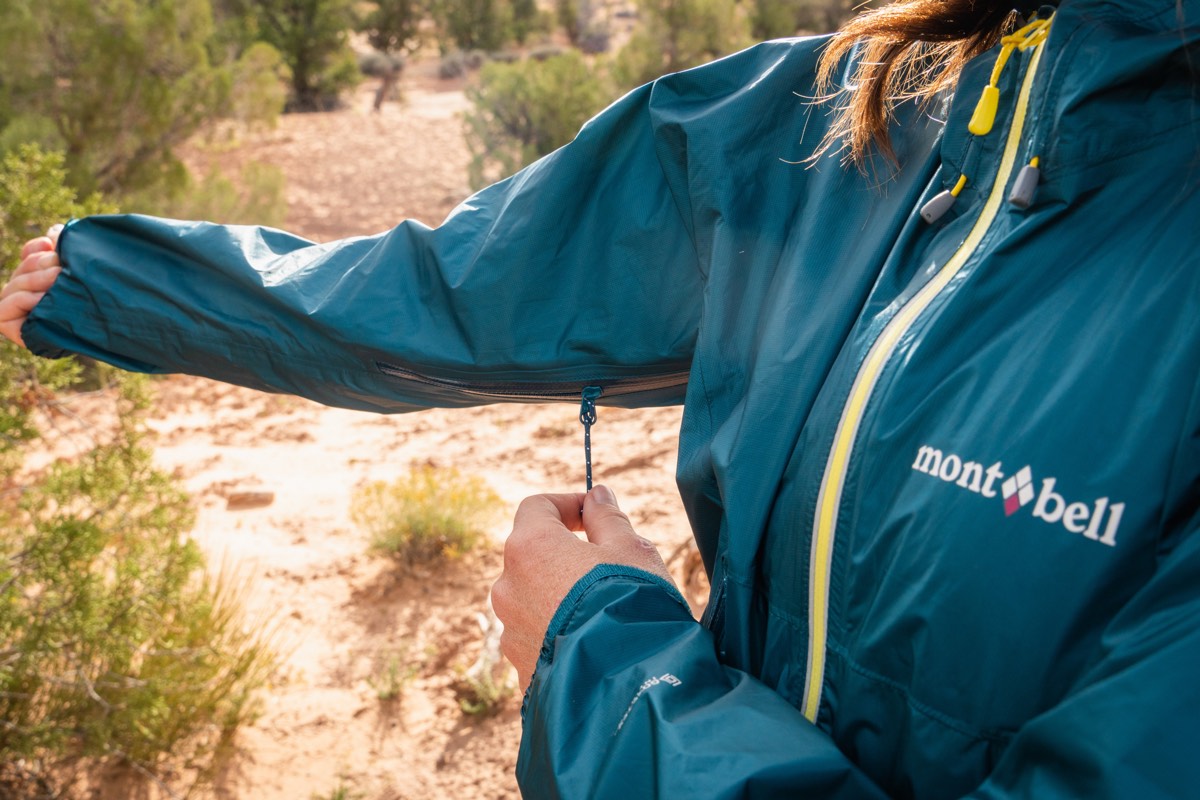
We love the pit zips on the Montbell Versalite Jacket, which is a great running rain jacket. Photo: iRunFar/Eszter Horanyi
Waterproof Versus Water-Resistant
The waterproof protection offered by running jackets varies, from repelling a few sprinkles to keeping out a monsoon. A water-resistant jacket will provide protection from a brief shower with the help of a durable water repellent (DWR) coating. These jackets will not keep you dry in extended wet weather, as the underlying materials are not waterproof themselves, and persistent rain will overwhelm the DWR. You can check out our running windbreaker jacket guide for some great examples of lightweight, water-resistant running jackets.
Waterproof jackets like the jackets featured in this guide have the ability not only to repel water from their surface but also prevent water from seeping into and soaking through the fabric. These will keep you dry during prolonged wet conditions, such as a long, soaking rain or wet snow.
Waterproof jackets are most often composed of multiple layers of materials that repel and shed moisture and will often include a DWR coating. There is also additional protection built into vulnerable areas, such as openings around the neck, hood, and wrists, as well as the zippers and seams. For true protection from the elements, a waterproof jacket is the piece of gear you will need. All of the features of the Montbell Rain Trekker Jacket, including its waterproof qualities, led us to name it the best running rain jacket.
Breathability
The main purpose of a rain jacket is to keep you dry. However, the tradeoff for this is often breathability. The best running rain jackets have come a long way from the days of plastic bag-like ponchos, and many offer both excellent moisture protection and breathability. The conditions in which you will be using your jacket can inform the balance you choose. For brief showers in warm climates, you can sacrifice a little waterproof capability for more breathability, whereas you may want to prioritize waterproofness in an all-day soaker with temperatures hovering just above freezing. The Montbell Versalite Jacket has pit zips to increase its breathability without sacrificing the waterproofness of the jacket material.
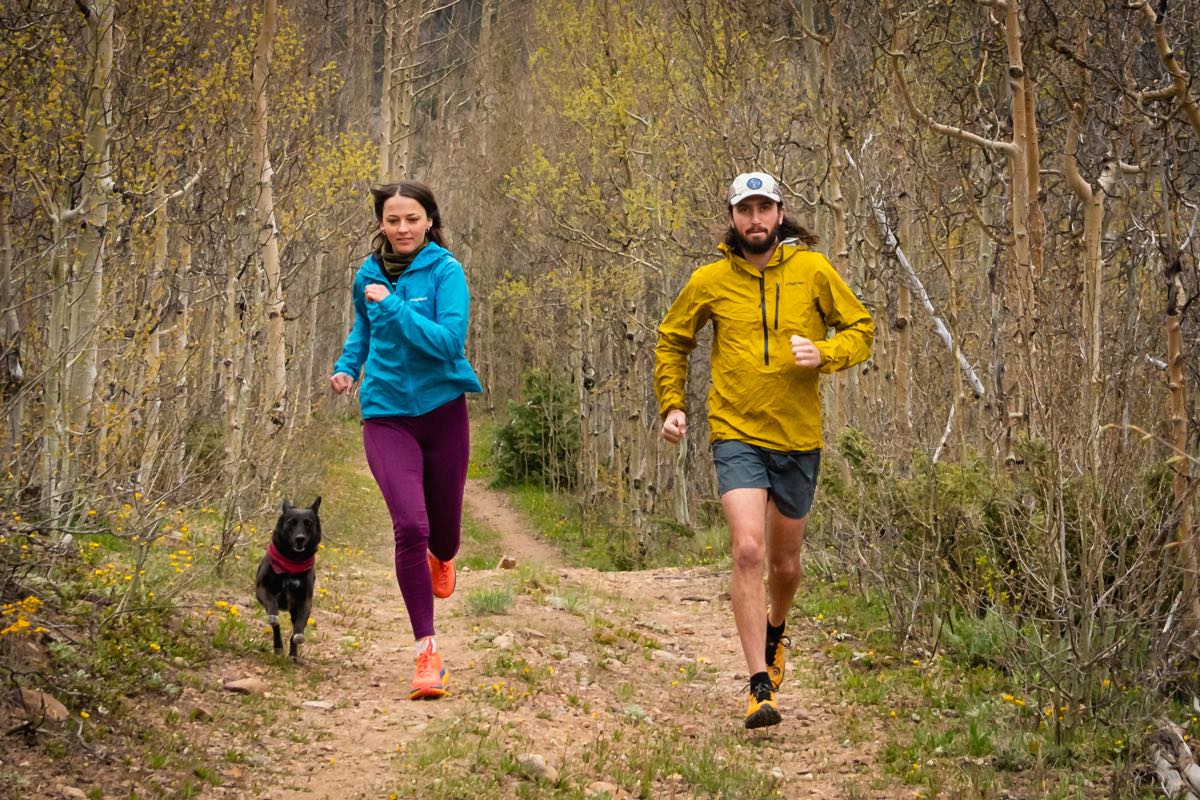
Hallie Taylor, Ben Kilbourne, and Easy the Dog test rain jackets on a stormy spring day in Colorado. Photo: iRunFar/Eszter Horanyi
Waterproof jackets improve their breathability by using fabric with permeable membranes that have microscopic holes big enough to let water vapor from your body escape but small enough to block water droplets from the outside. This technology comes at a premium, though — generally, the more lightweight and breathable a waterproof jacket is, the higher the price tag. A pricey jacket with all the bells and whistles may not make sense for everyone, but if you are spending hours running in a cold and soaking rain, the combination of good breathability and waterproof capability can quite literally be a lifesaver.
There are laboratory values that quantify a jacket’s breathability — see our answer to the frequently asked question of “How is breathability measured?” below. These measures give a reference point for the objective breathability of a material, but as with many types of technology that are analyzed in a lab, real-world performance doesn’t always agree. Real-world breathability can depend on several external factors, like temperature, humidity, or a person’s sweat rate.
Protection
Staying dry when the wet weather rolls in is the very reason you are looking for the best running rain jacket. As we mentioned above, the ways a rain jacket provides its waterproof protection will vary from brand to brand but generally is a waterproof membrane — such as Gore-Tex, eVent, or Pertex — that is layered with other fabrics.
A rain jacket is often described as having layers, either two layers, 2.5 layers, or three layers. In a two-layer jacket, such as the Montbell Rain Trekker Jacket and Montbell Versalite Jacket, an outer layer of durable water repellent (DWR)-coated nylon is layered or bonded to a waterproof membrane, such as Gore-Tex or similar.
A 2.5-layer jacket, such as our ultralight winners, the inov-8 Raceshell HZ Unisex and Rab Phantom Waterproof Pull-On Jacket, adds a coating on the innermost layer of the jacket to protect it from body oils, sweat, and other substances that can degrade the material. This coating is often referred to as a half layer because it’s not actually a full material layer.
A three-layer jacket features the outer layer bonded to the waterproof membrane, with an additional full inner layer of material. A three-layer jacket will, in theory, give you the most protection from the elements but at an increased weight and with reduced breathability.
When it comes to choosing a running jacket, more is not always more when it comes to layers. Most of our top choices for this guide are two- or 2.5-layer jackets, and that’s because we have found them to balance the waterproofness and breathability that runners want.
In addition to the materials and layer structure of the jacket, additional features such as taped seams and water-resistant zippers add an extra layer of protection to keep you dry.

The Outdoor Research Helium Rain Jacket is one of the best running rain jackets we tested. Photo: iRunFar/Eszter Horanyi
Features
There are several features to look for that enhance the fit and function of a quality waterproof jacket. While there are a whole host of bells and whistles that companies may tout to set their jackets apart from the rest, there are a few key features that we think are the most important to consider when shopping for a good running rain jacket.
- Hood: First off, a well-fitting hood is a must-have feature to keep rain and snow out. At the very least, the hood should include some elastic edging, like our top ultralight jackets, the inov-8 Raceshell HZ Unisex and Rab Phantom Waterproof Pull-On Jacket, to allow it to stretch around your head and face and stay in place while moving. A more full-featured jacket, such as the Montbell Rain Trekker Jacket, will have additional adjustment points, usually in the form of elastic draw cords, on the front and back of a hood that will help to cinch it in place, adjust the brim, and allow the hood to follow your head movements. A built-in brim on a hood, like the one on the Outdoor Research Helium Rain Jacket, will help to shed water and protect your face from the rain.
- Taped Seams: Seams are an unavoidable weakness in any jacket’s waterproofness that can allow moisture to get in. Fully waterproof jackets remedy this problem with a layer of material, usually thermoplastic tape, that is bonded and heat-sealed over the seams on the interior of the jacket.
- Zipper: Another potential moisture entry point on a jacket is the zipper. All the jackets featured in this buyer’s guide use water-resistant zippers that help seal out the elements. The technology in these zippers can cause some of them to move slower than a traditional fabric zipper, a factor we noticed most on the inov-8 Raceshell HZ Unisex.
- Adjustment Points: In addition to the elastic adjustments on the hood discussed above, many jackets will also include an elastic cord on the hem or waist to allow the wearer to cinch the bottom of the jacket and dial in a secure fit. Cuffs are another adjustment point, with some jackets including an elastic cinch, thumb loop, or Velcro strap to tighten or secure the cuffs to avoid slipping or riding up with arm motion.
- Pockets: Several of our top pick jackets have at least one pocket that can stash smaller items for easy access on the move. Your use of the jacket — wearing for long periods versus a just-in-case packable layer for short rains — will help guide your desire for an outer pocket. Bear in mind that pockets add zippers, create more seams, and add extra weight. You’ll want to forego pockets if you are looking for a lightweight jacket. When pockets are included, they often serve as a built-in stuff sack for packing the jacket away.
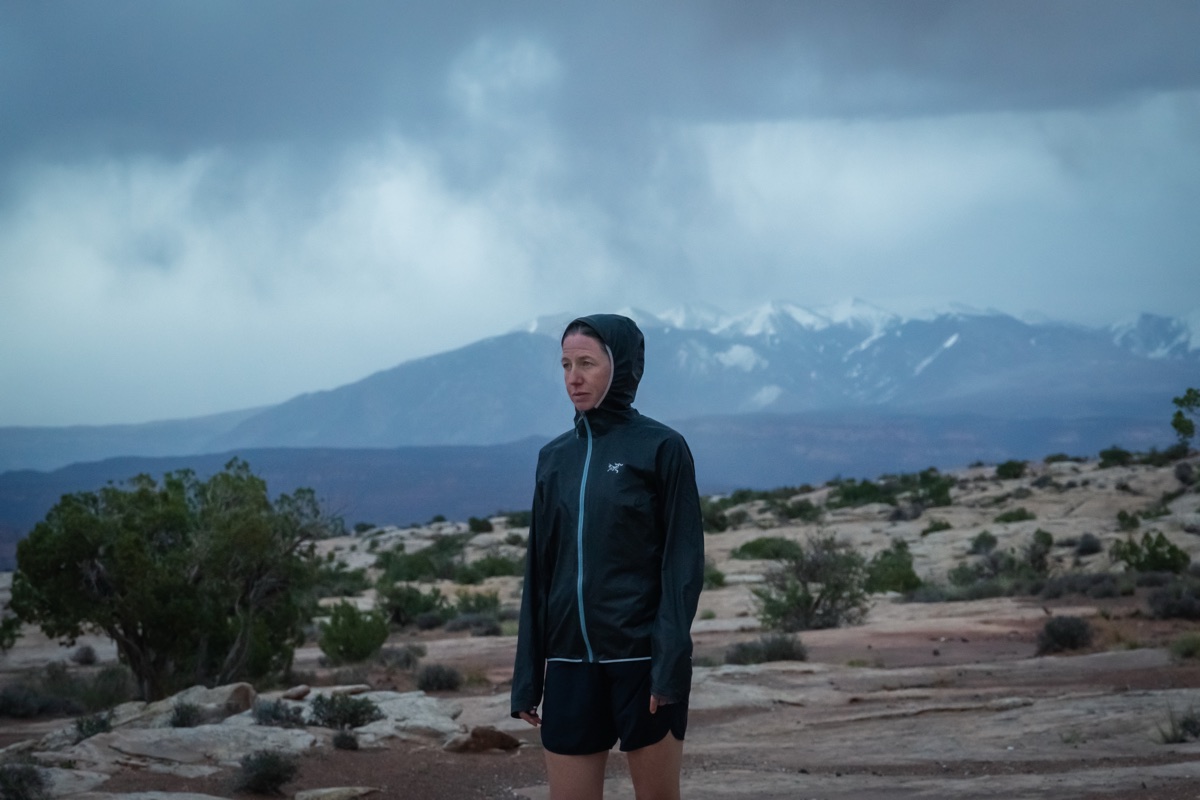
iRunFar’s Meghan Hicks tests an Arc’teryx rain jacket as a fall storm bears down on the desert around Moab, Utah. Photo: iRunFar/Eszter Horanyi
Weight
As material technology advances, so does the ability to have ultralight clothing. Men’s jackets, just by the nature of sizing and body mechanics, will be slightly heavier than women’s, but we can now measure that difference in grams rather than ounces. The more durable the material and the more bells and whistles, like pockets, zippers, and hoods, the heavier the jacket will be.
Our heaviest pick was the Montbell Rain Trekker Jacket, weighing around 200 grams. For a real-life reference, this is about the weight of a cup of sugar. The ultralight inov-8 Raceshell HZ Unisex and Rab Phantom Waterproof Pull-On Jacket came in at around half that, but that lightweight package means you are giving up some convenience factors like adjustable bungees on the hood and hem.
Storage
We trail runners aren’t always known for traveling light. We always have something we need to stash, be it our keys, snacks, or headlamp, and we like our pockets! But as we’ve said, there’s a tradeoff: more storage results in a heavier jacket. If you’re on an adventure where you want a jacket with many pockets, it’s likely you’re wearing something else with pockets, too, like a running pack, running shorts, or running belt.
Your rain jacket may be the one item where sacrificing storage and pockets is a wise choice. Storing items in a jacket will also up the bounce factor considerably and can create some issues with the fit, potentially creating gaps for water seepage. The Rab Phantom Waterproof Pull-On Jacket skips having pockets completely to alleviate the extra weight and potential problems caused by adding them.
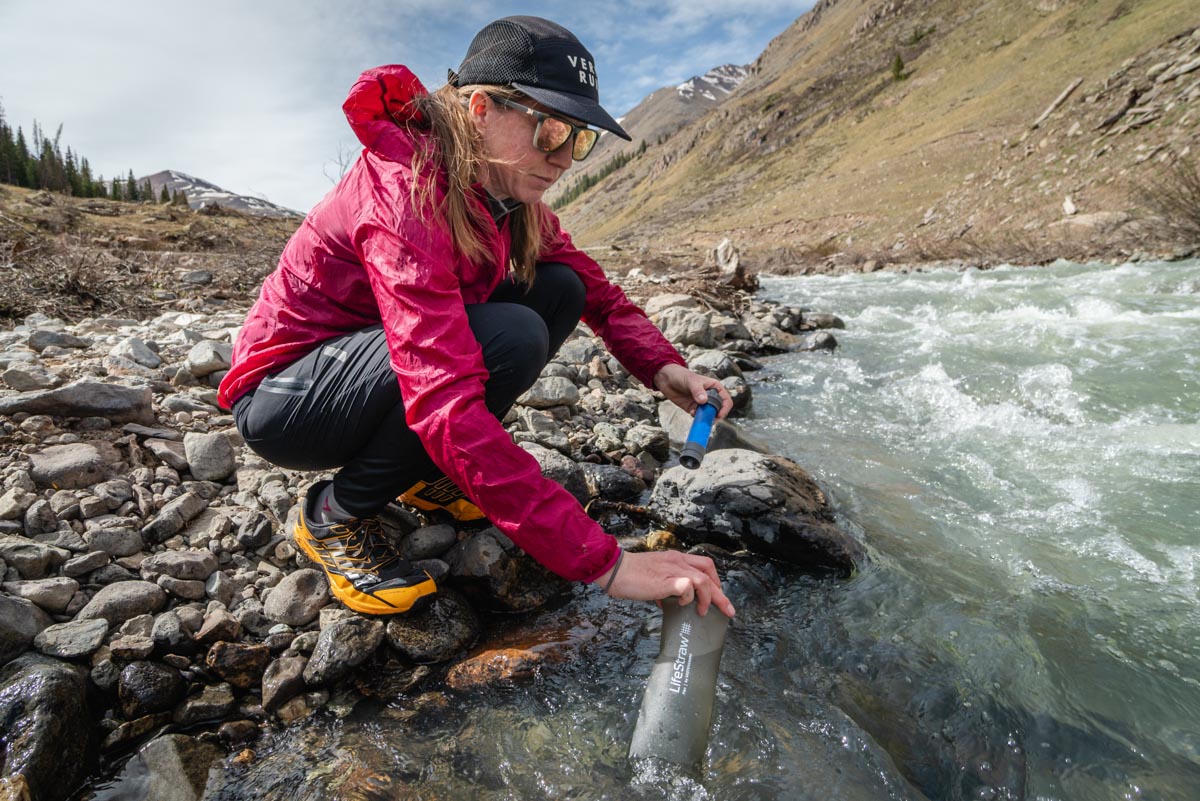
iRunFar Meghan Hicks wears a rain jacket for warmth while filtering water. Photo: iRunFar/Eszter Horanyi
Packability
Often during a long event, a rain jacket is more of a just-in-case layer or ends up being put on during a shower and taken off once the rain recedes. It is also part of the mandatory kit for several events. Your rain jacket will frequently just be taking a ride in your pack or waistbelt during a run, so it needs to be — you guessed it — packable.
Packability goes hand in hand with weight — usually, the lighter the jacket, the smaller it will pack down. Many of our top jacket picks have an internal pocket that the body of the jacket can roll into, producing a package no bigger than your fist that can easily stuff into a hydration pack. Others are a bit bulkier but provide increased insulation, waterproofing, and storage capacity. Those looking to shave as much weight and volume possible with a jacket will gravitate towards the 94-gram inov-8 Raceshell HZ Unisex, the lightest jacket we tested.
Layering
It is highly likely you’ll have to layer your jacket over some lighter layers, a hydration pack, or even another jacket. In many situations, it often makes sense to size up to give you room to fit your jacket over cool weather layers. A little more breathing room also means you can put your jacket on right over your pack, keeping your other gear dry and making donning and doffing your outer layer quicker and easier. Slimmer-fitting jackets, like the Rab Phantom Waterproof Pull-On Jacket, will need to be sized up if you want to add heavier layers underneath.
Why You Should Trust Us
Many members of the iRunFar team are based in the mountains, where some of the most unpredictable weather can occur. We’re used to sunny days turning to rain or a soft snowfall suddenly turning to a screaming sleet storm. We are committed to testing the best products out there in a variety of conditions so that you don’t have to suffer through the same trial and error out in the elements.
We started our testing process with market research: who is making the best product? We then polled our readers and iRunFar team members to choose the 20 or so rain jackets to test. What you see in this guide is the result of over one year of testing for all those jackets, where we ran them through winter snowstorms, cold dousers in the damn U.S. Pacific Northwest and high-altitude Mountain West, humid rainstorms, and everything in between in order to find the best running rain jacket for any type of weather condition.
Please note that in the running world, product models are routinely discontinued, while new ones frequently come to market. At the same time, we here at iRunFar often keep using our top picks in our daily running … they’re our top picks, after all! Sometimes that continued use results in uncovering product failures. With all this — product discontinuations, product introductions, and product failures — in mind, we routinely update our buyer’s guides based on past and ongoing testing as well as research by our authors and editorial team. While these updates can appear to be us pushing the newest product, it’s anything but that. When we update any buyer’s guide, most of the products are likely to remain the same. That matches our goal: to get you in the best gear that you’ll be using for a long time.
Frequently Asked Questions About Running Rain Jackets
Do I need a fully waterproof rain jacket for running, or will water-resistant be good enough?
This will largely depend on the climate in which you typically run. A warm-weather runner who might encounter an occasional shower can certainly get by with a lightweight, water-resistant jacket for those just-in-case moments.
For trail runners who are heading into the mountains or out for hours in constant rain and chilly temperatures, a fully waterproof jacket like the Montbell Rain Trekker Jacket is needed for comfort and safety. The combination of cold air temperatures and wet skin creates a high-risk scenario for hypothermia, which can become life-threatening very quickly. Having the right layers to protect against these elements means you will comfortably enjoy your adventure — and make it home to talk about it.
In addition, many races, particularly those in mountainous terrain or in cold, wet climates, have mandatory kit lists that require a waterproof jacket to be carried on your person for the duration of the event.
How are waterproof ratings measured on rain jackets?
While the waterproofness of a jacket is best determined by its performance in real-life conditions, there is laboratory testing that helps to establish a baseline rating for the materials used in the construction of waterproof clothing.
The most used measurement is the hydrostatic head, which is a measure of the amount of water a material can withstand before it starts to saturate and leak through. In this test, the fabric is secured over a one-inch diameter tube. Water is added to the tube, and the material is observed for a 24-hour period.
The height of the water column at which the water starts to saturate through the fabric and leak is the hydrostatic head, measured in millimeters. It is generally accepted that a hydrostatic head measurement of 10,000 millimeters is considered the baseline for waterproof jackets.
It should be noted that while many manufacturers will list hydrostatic head numbers in the specifications for their jackets, not all materials use this rating. Gore-Tex, which is used on the Montbell Versalite Jacket and the Montbell Rain Trekker Jacket, uses its own rain room to test its garments using specially designed rain nozzles and wind simulators to better approximate actual weather conditions.
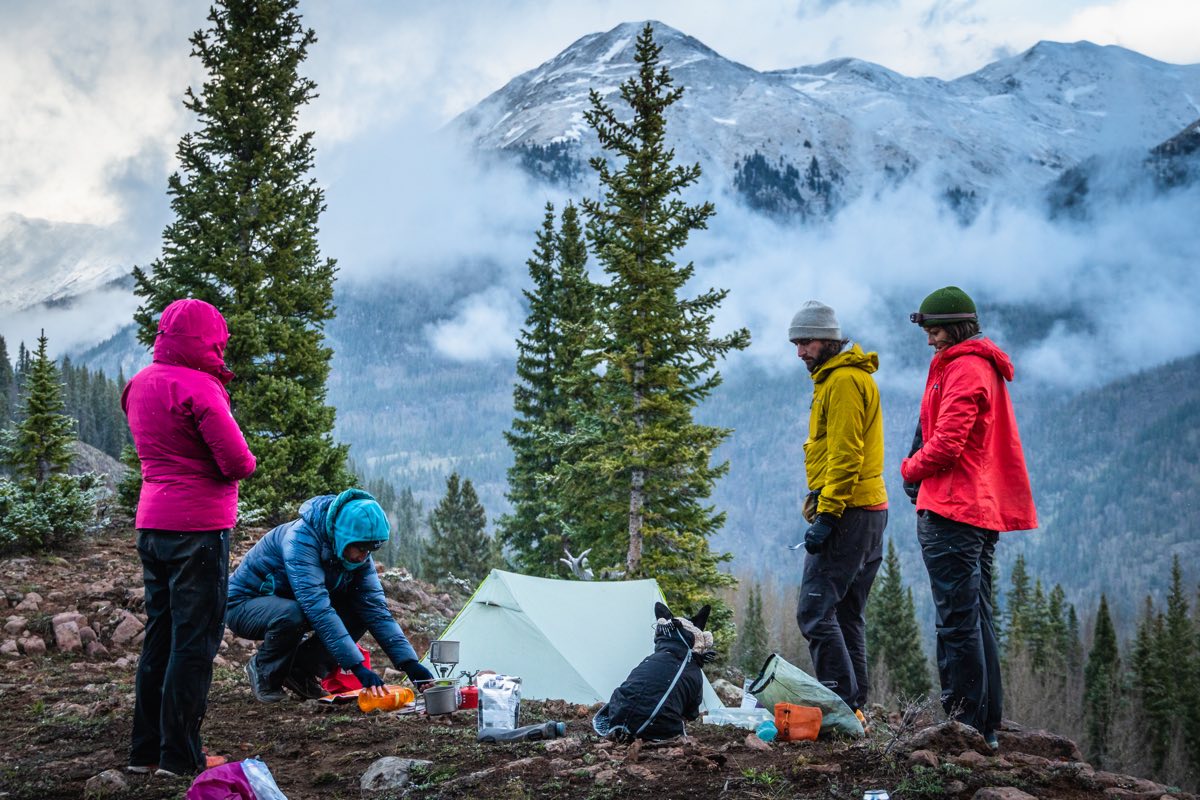
The iRunFar team tests rain jackets during a spring fastpacking trip in Colorado. Photo: iRunFar/Eszter Horanyi
How is breathability measured in a rain jacket?
Breathability is quantified through two types of laboratory-bestowed ratings. The first and most seen is Moisture Vapor Transmission Rate (MVTR). MVTR is a measurement of the rate that moisture (your sweat) permeates through the fabric. The higher the MVTR rating, the better, with good values starting around 10,000.
The second is Resistance to Evaporative Heat Loss (RET), which measures the resistance of the material to water vapor. The lower the RET, the better the breathability.
In theory, these numbers correlate to the breathability of the jacket. In practice, there are many other factors that impact a jacket’s comfort and breathability, and we prefer comparing performance in real-life conditions to making a purchase based on a lab value. The high breathability of the Montbell Rain Trekker Jacket was one of the factors that led us to name it our best rain jacket for running.
How long will a rain jacket’s waterproofing last?
Sadly, nothing lasts forever; but with proper care and maintenance, you should enjoy many dry and comfortable years with your waterproof jacket. There are several factors that will impact your waterproof jacket’s lifespan. Repeated exposure to rain and sweat/body oils will start to wear away at the material’s waterproof coating and membrane over time, as will frequent washing. Jackets with 2.5-layer construction, like the Rab Phantom Waterproof Pull-On Jacket, have an inner layer to protect the rest of the jacket from sweat and body oils.
All jackets will come with specific care recommendations, most often avoiding the use of standard detergents and high heat exposure, such as a clothes dryer, to avoid degradation of the material. That doesn’t mean you should never wash your jacket. Occasional washing with a laundry soap specifically formulated for use on waterproof materials will remove dirt and body oils that wear out waterproof fabrics.
An easy way to extend the life of a waterproof jacket is by refreshing the durable water repellent (DWR) coating. Apply a few drops of water to the exterior of your DWR-coated jacket — if the water soaks in instead of beading up and rolling off, your jacket has lost its water-resistant outer coating.
DWR coating can be reapplied by using a spray-on or wash-in product, such as Nikwax, that will bond to the outer material and refresh the jacket’s water-shedding capabilities. Always check your jacket’s care instructions and the instructions on the DWR-replenishment product before applying to be sure it is safe to use on those materials.
Is there a big difference between men’s and women’s rain jackets for running?
Along with other items of clothing, jackets are usually made for men’s and women’s specific body needs. Wide versus narrow shoulders, a straight cut versus a waist taper, and wider and narrower hips are only a couple of the differences between jackets made for different body types. Of course, if you find a jacket traditionally made for a different body type that feels the best for you, go with that one! The Rab Phantom Waterproof Pull-On Jacket has a slimmer fit than many of the other jackets we tested.
Most brands make equivalent models in both men’s and women’s jackets.
What size rain jacket should I buy to layer clothing and gear underneath?
If you want to layer heavier clothing or your hydration pack underneath, consider sizing up. Brands will generally give specific measurements, including chest, waist, and hip size, and sometimes even sleeve length and shoulder width, to ensure you get the best size for what you need. Most of the rain jackets that we tested, including our favorite, the Montbell Rain Trekker Jacket, would need to be sized up to fit bulky layers underneath.
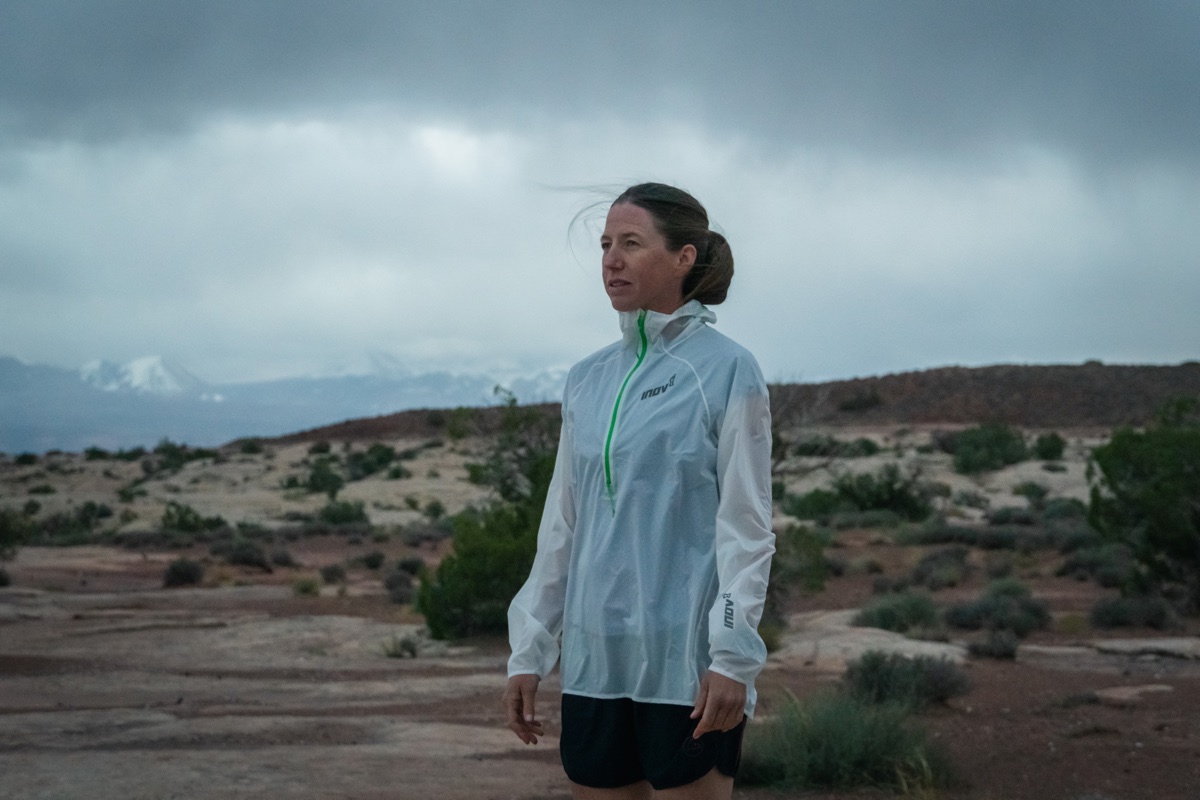
iRunFar’s Meghan Hicks models the inov-8 Raceshell HZ Unisex, which we named the best ultralight rain jacket for running. Photo: iRunFar/Eszter Horanyi
Should I prioritize a lightweight or protective rain jacket?
This comes down to personal preference, as well as how much you’re able to spend. Generally, the highest-priced items will offer both minimal weight and maximal protection. But if your budget is minimal, it’s likely you’ll have to sacrifice a bit of one or the other. If weight is your biggest concern, the inov-8 Raceshell HZ Unisex is a great option, even if it sacrifices style for saving grams. In the end, the best running rain jacket is one that you’re willing to carry, so you’ll want to get one that you’re not averse to putting in your pack for any run.
Is it worth paying more for an expensive rain jacket?
While technically, you can run in a trash bag or an inexpensive $3 poncho and stay relatively dry, there’s a lot to be said for investing in a high-quality rain jacket. A good rain jacket can keep you protected from the rain while allowing moisture from sweat to escape from the inside. A breathable and waterproof jacket isn’t inexpensive, but it can make running in the rain much more comfortable and safer. Well-constructed rain jackets can also last for a long time and be considered a great investment in your running gear. Proper care of a 2.5-layer jacket like the Outdoor Research Helium Rain Jacket can keep it waterproof for a long time.
Call for Comments
- What is your favorite running rain jacket and why?
- What features have you found to be the most practical and useful in your waterproof running jacket?
- What conditions or terrain do you most often find yourself reaching for a waterproof layer?
